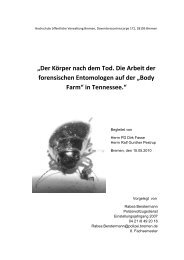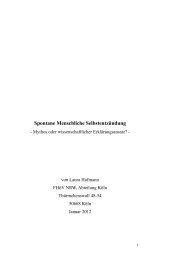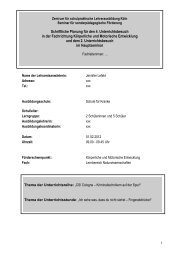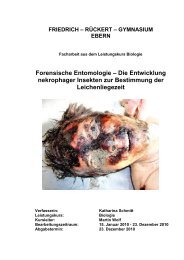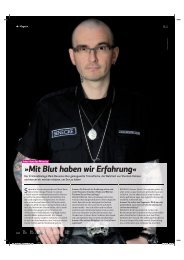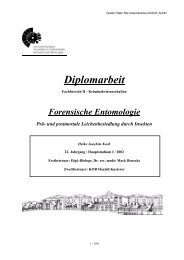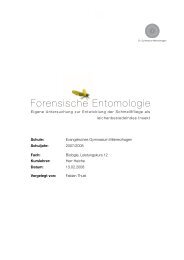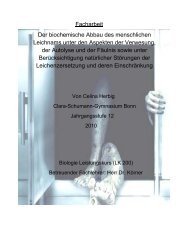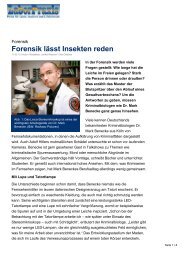A brief survey of the history of forensic entomology - Wiki2.benecke ...
A brief survey of the history of forensic entomology - Wiki2.benecke ...
A brief survey of the history of forensic entomology - Wiki2.benecke ...
Create successful ePaper yourself
Turn your PDF publications into a flip-book with our unique Google optimized e-Paper software.
24 MARK BENECKE<br />
1876 and 1879) and reported some <strong>of</strong> his<br />
results in his book “Faune des Tombeaux”<br />
(Fauna <strong>of</strong> <strong>the</strong> Tombs, 1887). No affiliation<br />
to a university or a Museum <strong>of</strong> Natural History<br />
was mentioned in his articles, and because<br />
he became a member <strong>of</strong> <strong>the</strong> French<br />
Academy <strong>of</strong> Medicine in 1893, one might<br />
conclude that he considered himself primarily<br />
a medical doctor.<br />
MÉGNIN drew on his 15 years <strong>of</strong> medicolegal<br />
experience with corpses in publishing<br />
14, mostly <strong>brief</strong>, papers between 1883 (see<br />
ANONYMUS 1883) and 1896. He found fault<br />
in <strong>the</strong> dissertation <strong>of</strong> his younger French colleague<br />
G.P. YOVANOVITCH, <strong>of</strong> <strong>the</strong> Faculty <strong>of</strong><br />
Medicine, Paris, on <strong>the</strong> same subject (YOVA-<br />
NOVITCH 1888). MÉGNIN was under <strong>the</strong> impression<br />
that YOVANOVITCH’s data were not<br />
sufficiently precise. Previously, <strong>the</strong> two researchers<br />
had co-operated in <strong>the</strong> sense that<br />
YOVANOVITCH was allowed to use MÉGNIN’s<br />
data, including tables <strong>of</strong> mites and <strong>the</strong> succession<br />
table <strong>of</strong> five cadaverous fauna waves<br />
that YOVANOVITCH titled ”Toilers on <strong>the</strong><br />
Dead” (“Les travailleurs de la mort”, obviously<br />
being a pun related to <strong>the</strong> book “Toilers <strong>of</strong><br />
<strong>the</strong> Sea” (“Les travailleurs de la mer” by <strong>the</strong><br />
French author V. HUGO, 1866).<br />
Finally, in 1894, MÉGNIN published his<br />
book “La faune des cadavres” (Fig. 8). In it,<br />
he expanded his former <strong>the</strong>ory <strong>of</strong> four insect<br />
waves for freely exposed corpses to eight successive<br />
waves. For buried corpses, he reported<br />
two waves. The book dealt with larval and<br />
adult forms <strong>of</strong> a number <strong>of</strong> families, and its<br />
drawings focused on wing venation, posterior<br />
spiracles, and overall anatomy <strong>of</strong> <strong>the</strong> insects<br />
for identification (Fig. 9). MÉGNIN also describes<br />
19 case reports, including his own<br />
cases between 1879 and 1888. (Some <strong>of</strong> <strong>the</strong><br />
cases were in co-operation with BROUARDEL.)<br />
He cites his original statements given in court<br />
as well as <strong>the</strong> basic questions asked <strong>of</strong> him as<br />
an expert witness.<br />
In addition to advancing <strong>the</strong> science <strong>of</strong> <strong>forensic</strong><br />
<strong>entomology</strong> MÉGNIN’s work greatly<br />
popularized <strong>the</strong> subject. His contributions<br />
to our knowledge <strong>of</strong> <strong>the</strong> arthropod fauna <strong>of</strong><br />
graves and <strong>the</strong> general fauna and flora <strong>of</strong><br />
mummified, or o<strong>the</strong>rwise decayed, corpses<br />
was later honored in <strong>the</strong> naming <strong>of</strong> <strong>the</strong> mold<br />
Endoconidium megnini.<br />
In 1897, inspired by MÉGNIN, <strong>the</strong> Canadian<br />
researches W. JOHNSTON and G. VILLE-<br />
NEUVE, <strong>of</strong> Montreal, started a number <strong>of</strong><br />
systematic entomological studies on human<br />
corpses. The two scientists write <strong>of</strong> MÉGNIN:<br />
“(...) in no single instance did <strong>the</strong> results <strong>of</strong><br />
<strong>the</strong> inquiry go to show that MÉGNIN’s deductions<br />
were erroneous. (...) The chief danger<br />
to be feared from MÉGNIN’s imitators is<br />
that <strong>the</strong>y might tend to indulge in guesses<br />
having no very solid basis and to apply rules<br />
to countries and climates where <strong>the</strong>y were<br />
inapplicable.” They aimed to refine <strong>the</strong> work<br />
<strong>of</strong> MÉGNIN and to adapt it to <strong>the</strong>ir local<br />
faunas.<br />
Ano<strong>the</strong>r study on this subject had already<br />
been set up by M.G. MOTTER, “Volunteer in<br />
<strong>the</strong> United States Bureau for Animal Industry”,<br />
and his co-workers a few years previous.<br />
Shortly after, in <strong>the</strong> summers <strong>of</strong> 1896<br />
and 1897, MOTTER‘s group systematically<br />
and critically checked more than 150 exhumed<br />
corpses from Washington, D.C. In<br />
his report, MOTTER (1898) provides <strong>brief</strong><br />
descriptions <strong>of</strong> <strong>the</strong> entomological findings<br />
as well as <strong>brief</strong> comments on soil type,<br />
grave depth, etc. A speech he “read before<br />
<strong>the</strong> public section <strong>of</strong> <strong>the</strong> British Medical Association”<br />
in 1897 carried <strong>the</strong> title “Underground<br />
Zoology and Legal Medicine” (MOT-<br />
TER 1897).<br />
Ano<strong>the</strong>r report in 1895 came from Sweden<br />
where SCHÖYEN gave an overview <strong>of</strong><br />
work that could be applied to <strong>the</strong> investigation<br />
<strong>of</strong> “graveness fauna”, or <strong>the</strong> fauna <strong>of</strong><br />
graves. (SCHÖYEN 1895). However, he refers<br />
primarily to species already mentioned in<br />
REINHARD’s and MÉGNIN’s publications. The<br />
only <strong>forensic</strong> <strong>entomology</strong> studies <strong>of</strong> that<br />
time no longer available are those performed<br />
by HOUGH in New Bedford from 1894 to<br />
1897, as he never published his data.



